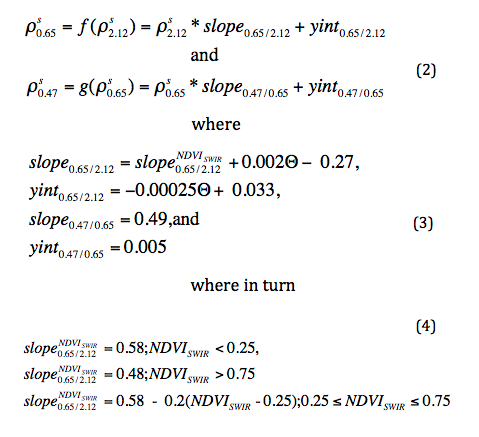The first step is to organize the measured reflectance into nominal (at nadir) 10 km by 10 km boxes (corresponding to 20 by 20, or 40 by 40 pixels, depending on the channel). The 400 pixels in the box are evaluated pixel by pixel to identify whether the pixel is suitable for aerosol retrieval. Clouds (Martins et al., 2002), snow/ice (Li et al., 2004) and inland water bodies (pixels with NDVI less than 0.1 are classified as inland or subpixel water) are considered not suitable and are discarded.
The non-masked pixels are checked for their brightness. Pixels having 2.12 µm measured reflectance between 0.01 and 0.25 are grouped and sorted. The brightest 50% and darkest 20% are discarded, in order to reduce cloud and surface contamination and scale towards darker targets. If there are at least 12 pixels remaining (10% of 30% of the original 400), then the reflectance in each channel is averaged, yielding the ‘MODIS-measured’ spectral reflectance ρm0.47, ρm0.65, ρm2.12, and ρm1.24. These reflectance values are used for ‘Procedure A’. If less then 12 pixels remain, then ‘Procedure B’ (described later) is followed and QAC is lowered to zero.
Surface Reflectance Assumptions
When performing atmospheric retrievals from MODIS or any other satellite, a major challenge is separating the total observed reflectance into atmospheric and surface contributions. Over the open ocean, the surface reflectance is nearly zero in the 0.65 µm so assuming negligible surface reflectance in these channels is a good approximation. Moving from coastline onto land, however, the surface reflectance in 0.65 µm and longer channels can be far from zero and vary over surface type. As the land surface and the atmospheric signals are comparable, errors of 0.01 in assumed surface reflectance can lead to errors on the order of 0.1 in τ retrieval (Kaufman et al., 1997b).
The surface reflectance in the visible wavelengths (0.47 µm and 0.65 µm) is parameterized as an empirically derived function of the 2.1 µm surface reflectance, NDVISWIR and scattering angle (Q). NDVISWIR is an aerosol resistant measure of vegetation ‘greenness’ using the 1.24 µm and 2.1 µm channels, defined as:

The surface reflectance in the 0.65 µm and 0.47 µm channels is parameterized as follows :

